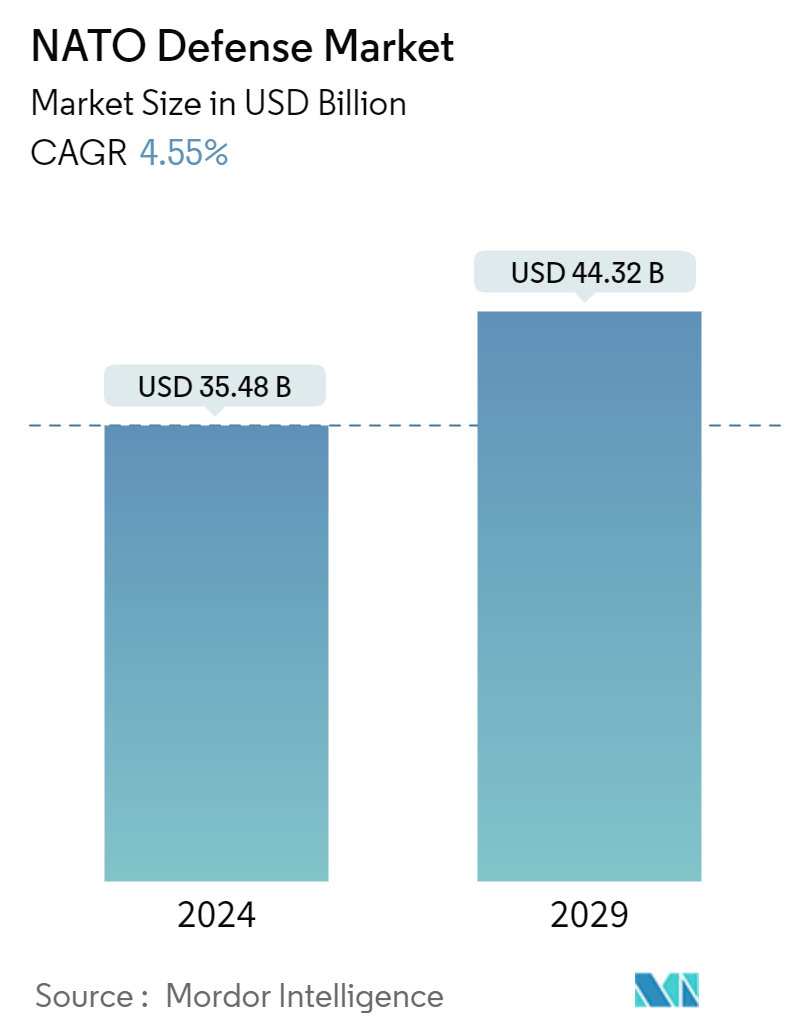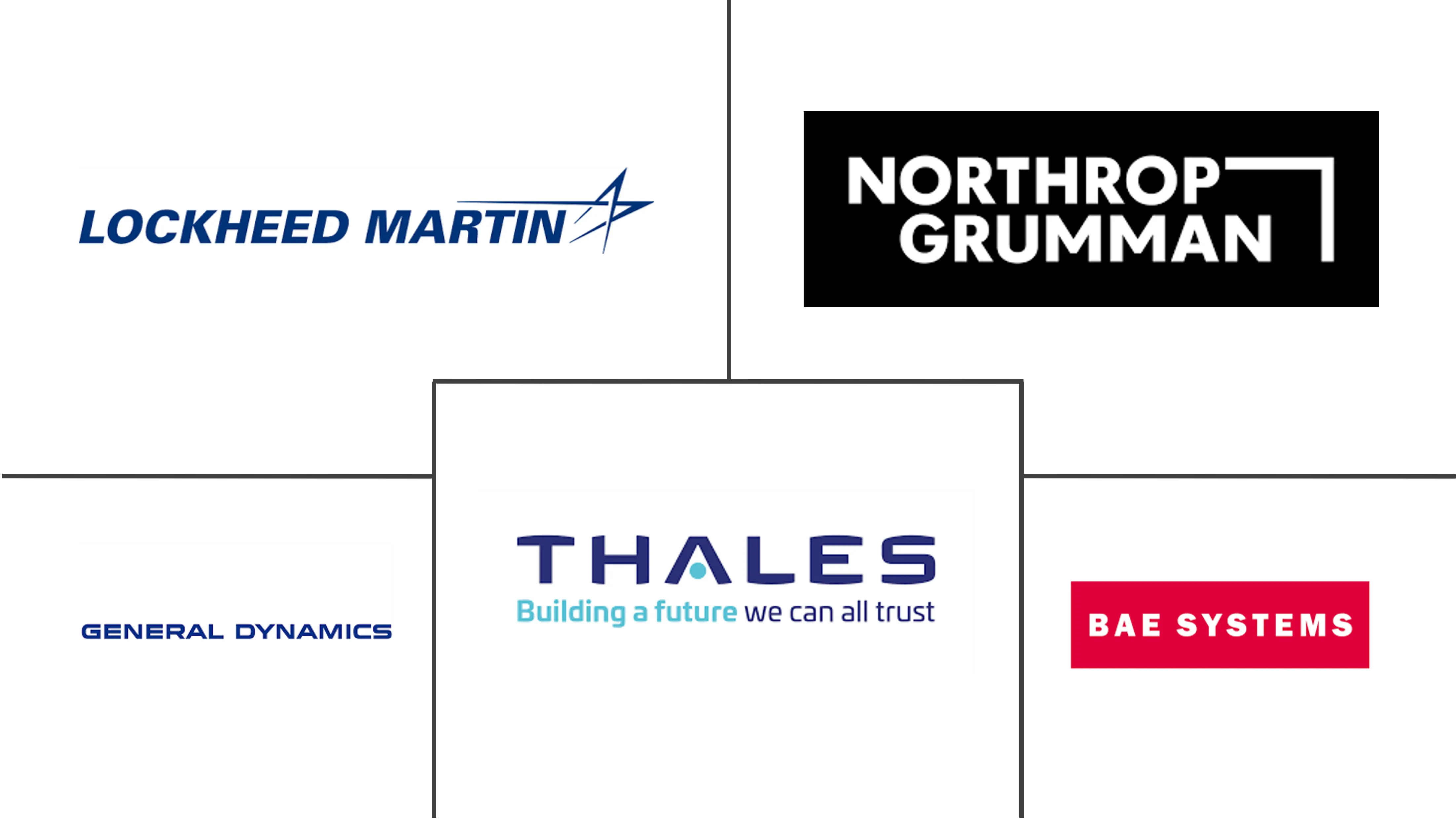Market Size of NATO Defense Industry

| Study Period | 2019 - 2029 |
| Base Year For Estimation | 2023 |
| Market Size (2024) | USD 35.48 Billion |
| Market Size (2029) | USD 44.32 Billion |
| CAGR (2024 - 2029) | 4.55 % |
| Market Concentration | Low |
Major Players
*Disclaimer: Major Players sorted in no particular order |
NATO Defense Market Analysis
The NATO Defense Market size is estimated at USD 35.48 billion in 2024, and is expected to reach USD 44.32 billion by 2029, growing at a CAGR of 4.55% during the forecast period (2024-2029).
The market is witnessing growth, propelled by increased defense spending and modernization efforts in major economies. However, economic, legal, and political regulations governing military procurement could impede this growth. The conflict between Russia and Ukraine has notably influenced the defense budgets of NATO countries, with many European nations bolstering their spending in response to Russia's actions.
Technological advancements and the pressing need for military modernization are critical drivers in the NATO defense market. As technology advances rapidly, global defense sectors must innovate to maintain their strategic advantages.
While the market's growth hinges on factors like fund allocation for new equipment, it faces challenges from rapid technological evolution, which can shorten the effective lifespan of new technologies. Nations are heavily investing in bolstering their military capabilities through new weapon procurements or modernizing their existing arsenals with advanced weaponry and next-gen missiles.
Besides addressing traditional security concerns like ballistic protection and ammunition reliability, the industry is pivoting toward cutting-edge technologies such as AI, unmanned systems, and advanced materials. These innovations not only enhance the armed forces' capabilities but also mitigate risks and boost the efficiency of military operations.
Compliance with regulatory standards, including testing and documentation, can be costly. Companies must invest in R&D, testing facilities, and specialized equipment to meet these standards. Furthermore, the high cost of adhering to NATO's regulations can pose a significant entry barrier for new market players. This could stifle competition and potentially hamper innovation, especially for smaller or newer businesses.
A prolonged shortage of critical components from a primary supplier can also lead to production delays. The materials used in defense systems must meet stringent quality benchmarks.
NATO Defense Industry Segmentation
The North Atlantic Treaty Organization (NATO), known as the North Atlantic Alliance, comprises 28 European and 2 North American countries. Established on April 4, 1949, NATO's core mission is to safeguard the freedom and security of its member nations through political and military strategies.
The NATO defense market is segmented by type and country. By type, the market is segmented into personnel training and protection, communication systems, weapons and ammunition, and vehicles. The report covers the market sizes and forecasts for the NATO defense market in NATO countries. For each segment, the market size and forecast are provided in terms of value (USD).
| Type | |
| Personnel Training and Protection | |
| Communication Systems | |
| Weapons and Ammunition | |
| Vehicles |
| Country | |
| United States | |
| United Kingdom | |
| Canada | |
| Turkey | |
| Italy | |
| Germany | |
| France | |
| Poland | |
| Spain | |
| Belgium | |
| Rest of NATO Countries |
NATO Defense Market Size Summary
The NATO defense market is experiencing a robust expansion, driven by increased defense spending and modernization efforts across major economies. This growth is significantly influenced by the geopolitical tensions, particularly the conflict between Russia and Ukraine, which has prompted many NATO countries, especially in Europe, to enhance their defense budgets. The market is characterized by a strong focus on technological advancements and military modernization, as nations strive to maintain strategic advantages through innovative defense solutions. However, the market's growth trajectory is challenged by economic, legal, and political regulations that govern military procurement, as well as the rapid pace of technological evolution, which can shorten the lifespan of new technologies. Despite these challenges, the demand for advanced weaponry and next-generation missiles is driving substantial investments in bolstering military capabilities.
The weapons and ammunition segment is poised for significant growth, fueled by a global military focus on enhancing ammunition reserves and the rising demand for training ammunition. This growth is further supported by NATO forces' involvement in peacekeeping and counter-insurgency missions, highlighting the ongoing necessity for ammunition. The market is also witnessing advancements in arms ammunition technology, with a shift towards smart ammunition that offers real-time battlefield data. The United States is expected to maintain its dominant position in the market, supported by substantial defense spending and a focus on capability enhancements. The ongoing geopolitical tensions and the need for heightened security are prompting nations to invest heavily in advanced weaponry. The NATO defense market remains fragmented, with several key players like Lockheed Martin, Northrop Grumman, and BAE Systems actively contributing to the supply of diverse defense equipment across NATO countries.
NATO Defense Market Size - Table of Contents
-
1. MARKET DYNAMICS
-
1.1 Market Overview
-
1.2 Market Drivers
-
1.3 Market Restraints
-
1.4 Porter's Five Forces Analysis
-
1.4.1 Bargaining Power of Buyers/Consumers
-
1.4.2 Bargaining Power of Suppliers
-
1.4.3 Threat of New Entrants
-
1.4.4 Threat of Substitute Products
-
1.4.5 Intensity of Competitive Rivalry
-
-
-
2. MARKET SEGMENTATION
-
2.1 Type
-
2.1.1 Personnel Training and Protection
-
2.1.2 Communication Systems
-
2.1.3 Weapons and Ammunition
-
2.1.4 Vehicles
-
-
2.2 Country
-
2.2.1 United States
-
2.2.2 United Kingdom
-
2.2.3 Canada
-
2.2.4 Turkey
-
2.2.5 Italy
-
2.2.6 Germany
-
2.2.7 France
-
2.2.8 Poland
-
2.2.9 Spain
-
2.2.10 Belgium
-
2.2.11 Rest of NATO Countries
-
-
NATO Defense Market Size FAQs
How big is the NATO Defense Market?
The NATO Defense Market size is expected to reach USD 35.48 billion in 2024 and grow at a CAGR of 4.55% to reach USD 44.32 billion by 2029.
What is the current NATO Defense Market size?
In 2024, the NATO Defense Market size is expected to reach USD 35.48 billion.

